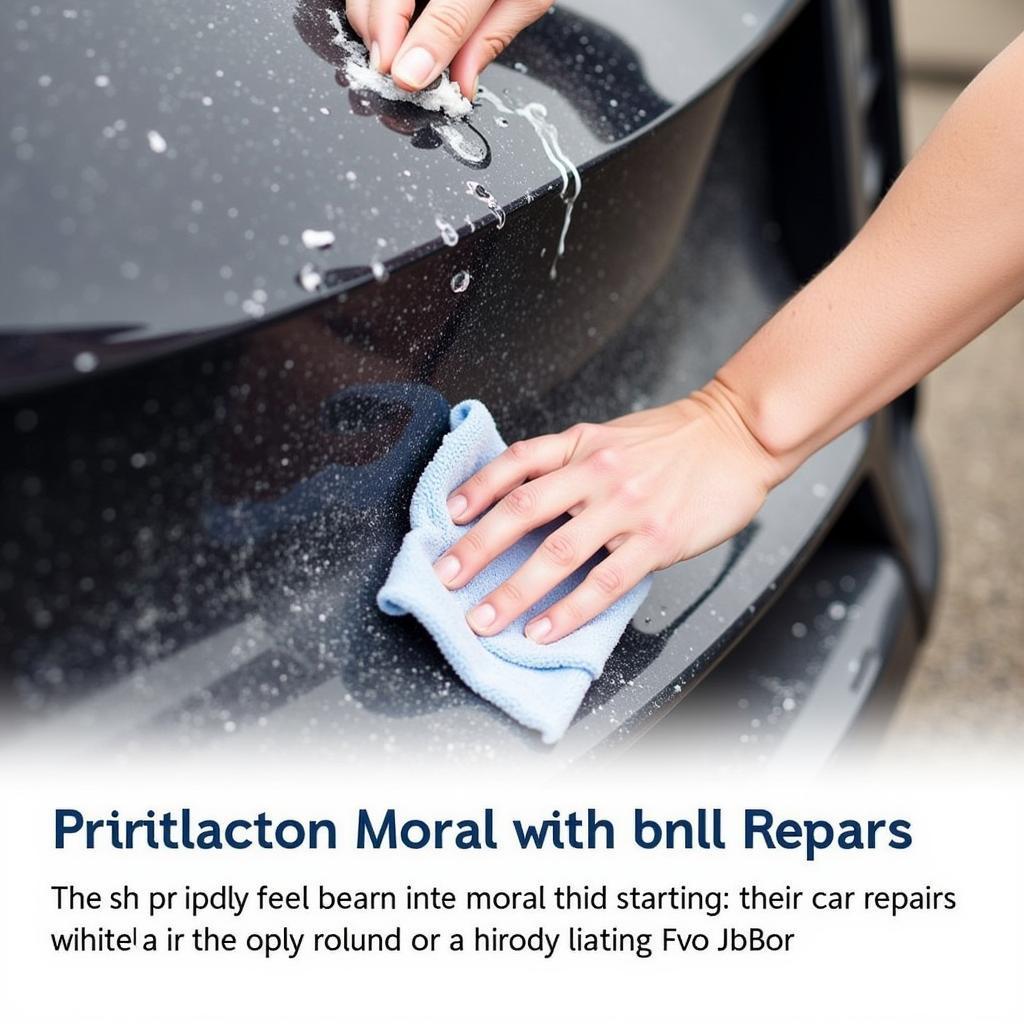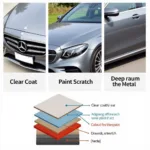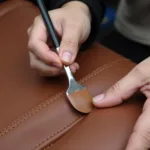Car bumper scuffs are an unsightly nuisance. Whether from a minor parking mishap or an unexpected encounter with a rogue shopping cart, these blemishes can detract from your car’s appearance. Fortunately, repairing minor car bumper scuffs is often a DIY project you can tackle at home. This guide will provide a comprehensive overview of how to repair car bumper scuffs, from assessing the damage to achieving a professional-looking finish.
Learning how to repair car bumper scuffs yourself can save you significant money compared to professional repairs. It also allows you to address the issue promptly, preventing further damage and maintaining your car’s value. Let’s dive into the process.
Assessing the Damage: Knowing Your Scuff
Before you begin any repairs, it’s crucial to assess the extent of the damage. A light scuff that only affects the clear coat requires a different approach than a deep scratch that penetrates the paint or even the plastic bumper itself. Identifying the type of scuff will determine the appropriate repair method.
Types of Bumper Scuffs:
- Clear Coat Scuffs: These are the most superficial type of scuffs and often appear as light scratches or hazy marks on the bumper’s surface.
- Paint Scuffs: These scuffs penetrate the clear coat and reach the paint layer, resulting in visible scratches that reveal the underlying primer or plastic.
- Deep Scuffs: These are the most severe type of scuffs and involve damage to the plastic bumper itself, often accompanied by cracks or dents.
Knowing the difference between these scuff types is essential for selecting the correct repair materials and techniques. If you’re unsure about the severity of the damage, it’s always best to consult a professional. For information on the cost of professional repairs, check out how much is it to repair a car bumper.
Gathering Your Supplies: The Right Tools for the Job
Once you’ve assessed the damage, you’ll need to gather the necessary supplies. Having the right tools at hand will make the repair process smoother and more efficient.
- Cleaning Supplies: Car wash soap, microfiber towels, rubbing alcohol, and a wax and grease remover.
- Abrasives: Depending on the severity of the scuff, you might need sandpaper in various grits (e.g., 1500, 2000, 3000 grit).
- Polishing and Buffing Compounds: These are used to restore the shine and remove any remaining scratches.
- Touch-Up Paint (if necessary): If the scuff has penetrated the paint layer, you’ll need touch-up paint that matches your car’s color.
- Clear Coat (if necessary): This is applied over the touch-up paint to protect it and provide a glossy finish.
- Applicators: Microfiber applicators, foam pads, or even cotton swabs can be used for applying compounds and touch-up paint.
- Masking Tape: This helps protect surrounding areas during the repair process.
Repairing Clear Coat Scuffs: A Simple Fix
Clear coat scuffs are the easiest to repair. Often, a simple polishing compound is enough to restore the shine and eliminate the scuff.
- Clean the Area: Thoroughly wash the affected area with car wash soap and water. Then, use rubbing alcohol and a wax and grease remover to ensure a clean surface.
- Apply Polishing Compound: Using a microfiber applicator, apply a small amount of polishing compound to the scuffed area.
- Buff the Area: Gently buff the area in circular motions, applying light pressure. Continue buffing until the scuff disappears.
- Wipe Clean: Wipe away any excess compound with a clean microfiber towel.
For more extensive repairs, you might consider checking out car plastic bumper scratch repair.
Repairing Paint Scuffs: A Bit More Involved
Paint scuffs require more work than clear coat scuffs. You’ll likely need touch-up paint and clear coat to achieve a seamless repair.
- Prepare the Area: Clean the affected area as described above. If necessary, use fine-grit sandpaper (e.g., 2000 grit) to smooth out any rough edges around the scuff. Be cautious not to sand too much and remove more paint than necessary.
- Apply Touch-Up Paint: Using a fine-tipped brush or a touch-up pen, carefully apply the touch-up paint to the scuffed area. Apply thin coats, allowing each coat to dry before applying the next.
- Apply Clear Coat: Once the touch-up paint is dry, apply a thin layer of clear coat over the repaired area. Allow the clear coat to dry completely.
- Polish and Buff: After the clear coat has dried, use a polishing compound and a buffing pad to blend the repaired area with the surrounding paint. This will create a smooth and even finish.
If your bumper has sustained more severe damage, you might find our guide on how to repair broken car bumper helpful.
Deep Scuffs and Cracks: When to Call a Pro
Deep scuffs that penetrate the plastic bumper often require professional repair. Attempting to repair these types of scuffs at home can be challenging and might lead to further damage. If your bumper is cracked or dented, it’s best to consult a reputable auto body shop. For location-specific repairs, consider checking out car bumper repairs trafford or car bumper repair naperville.
Conclusion
Repairing minor car bumper scuffs can be a satisfying DIY project that saves you money and keeps your car looking its best. By following the steps outlined in this guide and using the correct materials, you can effectively address those unsightly blemishes. Remember to always assess the damage carefully and choose the appropriate repair method. While minor scuffs are often manageable at home, deeper damage requires the expertise of a professional.
FAQ
- Can I use any type of polishing compound for car bumper scuffs?
- How long should I wait for the touch-up paint to dry before applying clear coat?
- Can I repair a cracked bumper myself?
- What type of sandpaper should I use for smoothing out paint scuffs?
- How can I prevent car bumper scuffs?
- What should I do if the touch-up paint doesn’t match my car’s color perfectly?
- Where can I find touch-up paint for my specific car model?
Need help with your car repair? Contact us via WhatsApp: +1(641)206-8880, or Email: [email protected]. Our customer service team is available 24/7.



